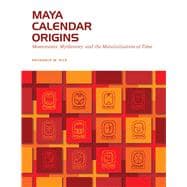
Note: Supplemental materials are not guaranteed with Rental or Used book purchases.
Purchase Benefits
What is included with this book?
| List of Figures and Tables | |
| Note on Orthography and Dates | |
| Preface | |
| Acknowledgments | |
| Introduction | |
| Popol Vuh , a Maya Creation Myth | |
| Time and Preclassic Mesoamerica | |
| Chiefdoms and Cycles | |
| The Early Maya and the Isthmian Region | |
| In the Beginning: Early Mesoamerican Prehistory | |
| Early Occupation: The Paleoindian or Lithic Stage | |
| The Archaic Stage | |
| The Archaic-to-Formative Transition | |
| The Early Mesoamerican Tradition | |
| Discussion | |
| Mesoamerican Calendrics: Time and Its Recording | |
| The 260-day Calendar | |
| The 360- and 365-day Calendars | |
| The Long Count and the May | |
| Origins of the Mesoamerican Calendars | |
| Recording Time | |
| Discussion | |
| Maya Calendar Developments in Broader Context | |
| Originally Thirteen Months? | |
| Beginnings and Endings | |
| The Months and the Day Names: A Derivational Model | |
| Calendrical Origins and the Popol Vuh | |
| Middle and Late Preclassic: The Gulf Coast Olmec and Epi-Olmec | |
| Architectural Patterns | |
| Monuments, Iconography, and Themes | |
| Discussion: Calendrical Implications | |
| The Epi-Olmec | |
| Discussion | |
| Late Preclassic: Izapa and Kaminaljuyu | |
| Izapa, Chiapas | |
| Kaminaljuyu and Related Sites | |
| Discussion: Calendrical Implications | |
| The Early Maya Lowlands: Origins and Settlements | |
| Origin Myths | |
| Archaeology: The Earliest Lowland Settlers and Their | |
| Languages | |
| Archaeology and Architecture | |
| Archaeology and Exchange | |
| Discussion | |
| Early Lowland Maya Intellectual Culture: Writing, Stelae, and "Government" | |
| Writing Systems | |
| The Stela "Cult" and Calendrics | |
| Ties to the Isthmus | |
| Leadership, Politics, and Government | |
| The Materialization and Politicization of Time | |
| Development of the Calendars | |
| The Popol Vuh and Calendars | |
| Pilgrimages and Tollans | |
| Cycling: Chiefly and Calendrical | |
| Maya Calendars: Order, Legitimacy, and Wealth | |
| Notes | |
| References Cited | |
| Index | |
| Table of Contents provided by Publisher. All Rights Reserved. |
The New copy of this book will include any supplemental materials advertised. Please check the title of the book to determine if it should include any access cards, study guides, lab manuals, CDs, etc.
The Used, Rental and eBook copies of this book are not guaranteed to include any supplemental materials. Typically, only the book itself is included. This is true even if the title states it includes any access cards, study guides, lab manuals, CDs, etc.